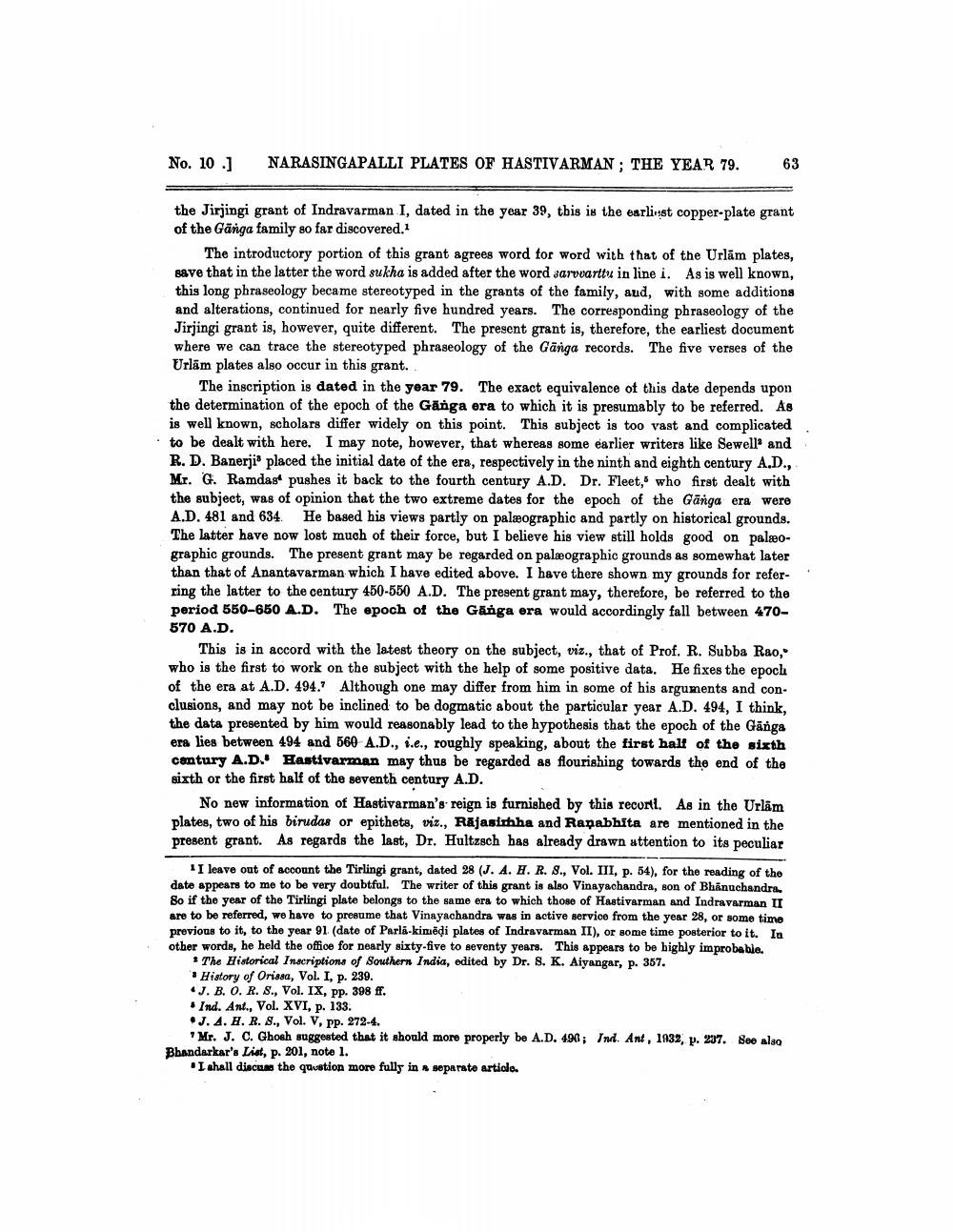________________
No. 10 .]
NARASINGAPALLI PLATES OF HASTIVARMAN; THE YEAR 79.
63
the Jirjingi grant of Indravarman I, dated in the year 39, this is the earliest copper-plate grant of the Ganga family so far discovered.1
The introductory portion of this grant agrees word for word with that of the Urlām plates, save that in the latter the word sukha is added after the word sarvvarttu in line i. As is well known, this long phraseology became stereotyped in the grants of the family, and, with some additions and alterations, continued for nearly five hundred years. The corresponding phraseology of the Jirjingi grant is, however, quite different. The present grant is, therefore, the earliest document where we can trace the stereotyped phraseology of the Ganga records. The five verses of the Urlām plates also occur in this grant.
The inscription is dated in the year 79. The exact equivalence of this date depends upon the determination of the epoch of the Ganga era to which it is presumably to be referred. As is well known, scholars differ widely on this point. This subject is too vast and complicated to be dealt with here. I may note, however, that whereas some earlier writers like Sewell and R. D. Banerjis placed the initial date of the era, respectively in the ninth and eighth century A.D., Mr. G. Ramdas pushes it back to the fourth century A.D. Dr. Fleet, who first dealt with the subject, was of opinion that the two extreme dates for the epoch of the Ganga era were A.D. 481 and 634. He based his views partly on palæographic and partly on historical grounds. The latter have now lost much of their force, but I believe his view still holds good on paleographic grounds. The present grant may be regarded on palaeographic grounds as somewhat later than that of Anantavarman which I have edited above. I have there shown my grounds for referring the latter to the century 450-550 A.D. The present grant may, therefore, be referred to the period 550-650 A.D. The epoch of the Gänga era would accordingly fall between 470570 A.D.
This is in accord with the latest theory on the subject, viz., that of Prof. R. Subba Rao, who is the first to work on the subject with the help of some positive data. He fixes the epoch of the era at A.D. 494. Although one may differ from him in some of his arguments and conclusions, and may not be inclined to be dogmatic about the particular year A.D. 494, I think, the data presented by him would reasonably lead to the hypothesis that the epoch of the Ganga era lies between 494 and 560 A.D., i.e., roughly speaking, about the first half of the sixth century A.D. Hastivarman may thus be regarded as flourishing towards the end of the sixth or the first half of the seventh century A.D.
No new information of Hastivarman's reign is furnished by this recorti. As in the Urlām plates, two of his birudas or epithets, viz., Rajasirhha and Rapabhita are mentioned in the present grant. As regards the last, Dr. Hultzsch has already drawn attention to its peculiar
1I leave out of account the Tirlingi grant, dated 28 (J. A. H. R. S., Vol. III, p. 54), for the reading of the date appears to me to be very doubtful. The writer of this grant is also Vinayachandra, son of Bhanuchandra. So if the year of the Tirlingi plate belongs to the same era to which those of Hastivarman and Indravarman II are to be referred, we have to presume that Vinayachandra was in active service from the year 28, or some time previous to it, to the year 91 (date of Parla-kimedi plates of Indravarman II), or some time posterior to it. In other words, he held the office for nearly sixty-five to seventy years. This appears to be highly improbable.
The Historical Inscriptions of Southern India, edited by Dr. S. K. Aiyangar, p. 357.
History of Orissa, Vol. I, p. 239.
J. B. O. R. S., Vol. IX, pp. 398 ff.
Ind. Ant., Vol. XVI, p. 133.
J. A. H. R. S., Vol. V, pp. 272-4.
"Mr. J. C. Ghosh suggested that it should more properly be A.D. 496; Ind. Ant, 1932, p. 237. See also Bhandarkar's List, p. 201, note 1.
I shall discuss the question more fully in a separate article.




